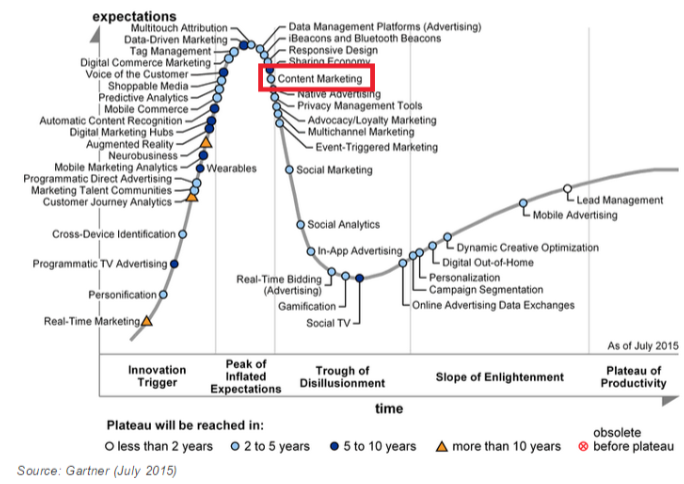Unlocking the potential of your content marketing team
| August 7, 2019

The biggest challenge facing content marketing isn’t creating better content; it’s how we manage that content in a way that helps teams work better together.
If you are a content marketer, chances are you’ve seen this scary chart that’s made you a little anxious about the impact you have at work:

You don’t need a degree in math to know that up is good, down is bad, and this graph of the effectiveness of content marketing is trending down over time. Yikes.
Amidst all the articles doomsaying the “death of content marketing,” though, emerges a clear solution: make better content. Many claim that creating content that stands out in a saturated digital sea is the biggest challenge of content marketing.
Easier said than done, but underneath this challenge is the larger issue of unlocking team flow so that people are most empowered to create better content. Like with most professional hurdles, it really comes down to how people work within teams, and how we can oil the gears so that folks are able to perform at their best.
More people, more tech, more problems
We’re at the point where content underlies every function of marketing. As content marketing teams are trusted with more budget and asked to bring in more value, they have grown not only larger in number but also more complex in workflows.
Thanks to our eagerness to create fresh, exciting content, today’s content marketing teams are larger and more diverse. Teams are both growing in number and expanding beyond traditional marketing and content writing roles as content becomes more multimedia. Content marketing teams now include graphic designers, photographers, videographers, and podcasters who may work in-house, on a freelance or contract basis, or as part of an outside agency.
In addition, content marketers are using more robust technology stacks. Workflows revolving around content – creating it, storing it, finding it, sharing it – have become increasingly complex as teams grow larger, and the number of tools we use has scaled as we try to meet these needs.
So, while content marketing is more fun, exciting, and innovative than ever, this new era also comes with the challenges of working with larger, diverse, and distributed teams and these convoluted, sometimes bloated tech stacks. How do you centralize and organize all of this new content your team is creating so that the people who need it can find it? How do you collaborate and share this content with both internal team members and outside agencies and freelancers? How do you send brand assets to media without blowing up your email storage with hi-res image attachments?
The consequences of content chaos
The reality for most content marketing teams is that digital assets are sprawled in a haphazard composite of various cloud-based file-sharing applications such as Google Drive, Dropbox, and Box, as well as email or Slack attachments. These teams don’t have the resources to hire one person dedicated to managing digital assets even as they produce more and more content, so the assets either go unmanaged or the responsibility falls upon someone who already has a full-time job. Neither is a sustainable option for the team’s long-term growth.
At a previous content marketing job, I took on the responsibility of managing our team’s various contractors and freelancers, and by extension, the digital assets they created. I ended up becoming a bottleneck for accessing assets and my inbox was cluttered with email attachments that I had to manually upload to our asset library in Google Drive. Although my main role was to develop content, I spent more time fulfilling asset requests from various team members and external contributors than, well, doing my job.
For many marketing and creative professionals, that’s probably a familiar story. In my current role at Canto, I’ve talked to customers who used to spend half their work hours fulfilling asset requests before they decided to invest in a digital asset management (DAM) solution – and I’ve heard them rave about the time they’ve gotten back once they implemented Canto.
Unlocking team flow
If your content marketing team is struggling to gain traction, take a look at your team dynamics. Is your team empowered to spend as much time and energy as possible towards creating innovative, high-quality content? Or are they trapped in a never-ending deluge of image requests in their inboxes? And if so – why are you paying top dollar for talented employees to push assets back and forth instead of bringing value to your organization?
Whether you’re a content marketer, a designer, a photographer, or a writer, we all want to spend more time doing our jobs and doing them well…not chasing down images or being a bottleneck for our team. Cleaning up your organization’s act when it comes to digital asset management will not only help your team work more efficiently, but also boost morale and make space for the creativity you need to succeed in a saturated market.
